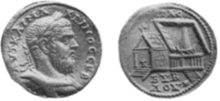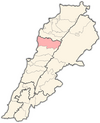 The temple excavations in 1950 The temple excavations in 1950 | |
 | |
| Location | Byblos |
|---|---|
| Coordinates | 34°07′09″N 35°38′45″E / 34.11917°N 35.64583°E / 34.11917; 35.64583 |
| Site notes | |
| Excavation dates | 1922 |
The Temple of Baalat Gebal (Arabic: معبد بعلة جبيل maebad baalat jbeil) was an important Bronze Age temple structure in the World Heritage Site of Byblos. The temple was dedicated to Ba'alat Gebal, the goddess of the city of Byblos, known later to the Greeks as Atargatis. Built in 2800 BCE, it was the largest and most important sanctuary in ancient Byblos, and is considered to be "one of the first monumental structures of the Syro-Palestinian region". Two centuries after the construction of the Temple of Baalat Gebal, the Temple of the Obelisks was built approximately 100m to the east.
The length and continuity of its history as an active temple is "remarkable" and "supports its centrality in the life of the city".
An important group of Byblos figurines were found in the temple; these figurines have become the "poster child" of the Lebanese Tourism Ministry.
Background
The temple, and its patroness, Ba‘alat Gebal, were venerated in the city for more than two millennia during the Canaanite and Phoenician eras. It was constructed when Byblos had close ties with Egypt, and a number of Egyptian references are found throughout the temple complex. The temple itself was expanded a number of times and remained in use until the Roman era.
Modern identification and excavation

The site of the temple is near the Crusaders' Byblos Castle, and was first excavated by French archaeologist Pierre Montet from 1921–24 and subsequently in the early part of Maurice Dunand's excavation of the city. Montet published two sketches of his excavations, and Dunand published a few plans for the wider sector of excavations in his 1939 volume. Almost all of the artifacts found in the excavation of the temple are displayed at the National Museum of Beirut.
The temple now sits east of the Roman theater. The theater, built around AD 218, was reconstructed and moved to allow excavation of the temple site.
Gallery
-
 View of the temple's inner rooms’ foundations
View of the temple's inner rooms’ foundations
-
 Montet's 1924 diagram of the Byblos archaeological site
Montet's 1924 diagram of the Byblos archaeological site
-
 Montet's 1924 diagram of the Byblos temples
Montet's 1924 diagram of the Byblos temples
-
 The Byblos figurines
The Byblos figurines
Notes
- Boda 1994, p. 146.
- Espinel, Andrés Diego (2002). "The Role of the Temple of Ba'alat Gebal as Intermediary between Egypt and Byblos during the Old Kingdom". Studien zur Altägyptischen Kultur. 30: 103–119. JSTOR 25152861.
- ^ Bryce 2009, p. 138.
- ^ Kilani 2019, p. 53-54.
- Kilani 2019, p. 54.
- WorldWide: Lebanon, Biblical Archaeology Review 34:5, September/October 2008
- Hakimian, Suzy (2008). "Byblos: Standing Figures". Beyond Babylon: Art, Trade, and Diplomacy in the Second Millennium B.C. Metropolitan Museum of Art. pp. 52–53. ISBN 978-1-58839-295-4.
More than fifteen hundred male figurines...
- Aubet, Maria Eugenia (31 January 2013). Commerce and Colonization in the Ancient Near East. Cambridge University Press. pp. 240–. ISBN 978-0-521-51417-0.
The most characteristic assemblage of offerings is without doubt the bronze figurines representing Baal, many of them covered in gold plate. Almost 2,000 figurines of this type have been found — an important group coming from the Temple of Baalat Gebal — the majority in the Temple of the Obelisks, where more than twenty votive deposits and pitchers with figurines of different typologies have been found
- Steiner, Margreet L.; Killebrew, Ann E. (2014). The Oxford Handbook of the Archaeology of the Levant: C. 8000-332 BCE. OUP Oxford. pp. 465–. ISBN 978-0-19-921297-2.
- "Byblos Castle". Retrieved 2013-03-02.
- Montet 1928, p. Plates xxi, xxii.
- Dunand 1937.
- Michaelides 2001, p. 21.
- "The archaeological site of Byblos".
References
- Boda, Sharon La (1994). International Dictionary of Historic Places: Middle East and Africa. Taylor & Francis. ISBN 978-1-884964-03-9.
- Michaelides, Demetrios (2001), Report on Mission to Byblos (Lebanon), International Council on Monuments and Sites
- Espinel, Andrés Diego. “The Role of the Temple of Ba'alat Gebal as Intermediary between Egypt and Byblos during the Old Kingdom.” Studien Zur Altägyptischen Kultur, vol. 30, 2002, pp. 103–119. JSTOR, www.jstor.org/stable/25152861.
- Bryce, Trevor (10 September 2009). The Routledge Handbook of the Peoples and Places of Ancient Western Asia: The Near East from the Early Bronze Age to the Fall of the Persian Empire. Routledge. ISBN 978-1-134-15908-6.
- Kilani, Marwan (24 October 2019). Byblos in the Late Bronze Age: Interactions Between the Levantine and Egyptian Worlds. Brill. ISBN 978-90-04-41659-8.
Archaeological reports
- Montet, Pierre (1928). Byblos et l'Égypte: quatre campagnes de fouilles à Gebeil, 1921-1922-1923-1924. P. Geuthner.
The text volume is available here
{{cite book}}: External link in|quote= - Dunand, Maurice (1937). Fouilles de Byblos: Atlas : 1926-1932. P. Geuthner.
External links
 Media related to Temple of Baalat Gebal at Wikimedia Commons
Media related to Temple of Baalat Gebal at Wikimedia Commons
| Capital: Byblos | ||
| Towns and villages |
|  |
| Landmarks |
| |